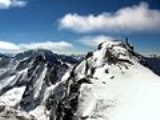
in the Bregaglia Range
, located on the border between Italy
and the Swiss
canton
of Graubünden
.
It is by the straight line and the circle that the first and most simple example and representation of all things may be demonstrated, whether such things be either non-existent or merely hidden under Nature's veils.![]()
Neither the circle without the line, nor the line without the point, can be artificially produced. It is, therefore, by virtue of the point and the Monad that all things commence to emerge in principle. That which is affected at the periphery, however large it may be, cannot in any way lack the support of the central point.![]()
Therefore, the central point which we see in the centre of the hieroglyphic Monad produces the Earth, round which the Sun, the Moon, and the other planets follow their respective paths. The Sun has the supreme dignity, and we represent him by a circle having a visible centre. ![]()
Although the semicircle of the Moon is placed above the circle of the Sun and would appear to be superior, nevertheless we know that the Sun is ruler and King. We see that the Moon in her shape and her proximity rivals the Sun with her grandeur, which is apparent to ordinary men, yet the face, or a semi-sphere of the Moon, always reflects the light of the Sun.![]()
We finish the brief hieroglyphic consideration of our Monad, which we would sum up in one only hieroglyphic context: The Sun and the Moon of this Monad desire that the Elements in which the tenth proportion will flower, shall be separated, and this is done by the application of Fire.![]()

